![]()
Are you looking for a user manual template because you need to create a user manual by yourself? Then this article will be very useful for you. Our manual template will help you set up a guide for your machinery, electrical product, toy or medical device. Download our user guide template and follow the steps as described in this case study.
In this article I’m going to show you how one entrepreneur used the User Manual Template to create his own compliant, user-friendly and appealing user manual.
And he did this without any knowledge of technical writing.
Philip is a Swedish 34-year business owner and inventor of the ISOVOX2, a portable vocal studio.
Like many startup companies, Philip needs to be very careful about where he spends his money. Most time and money needs to be spent on product development and setting up the sales channels.
His product needs a user guide, however. He knows that there are some legal requirements for the content of the manual. Also, he wants a well designed and user-friendly instructional manual that contributes to a good customer experience.
As he has some resources in-house, he does not want to outsource the full development of the manual. I decided to walk him through the entire process and developed an instruction manual template for him. Here’s what happened.
I sent him a few emails, explaining step-by-step how to use the right user manual template for his product. The results are as follows:
See the result here:
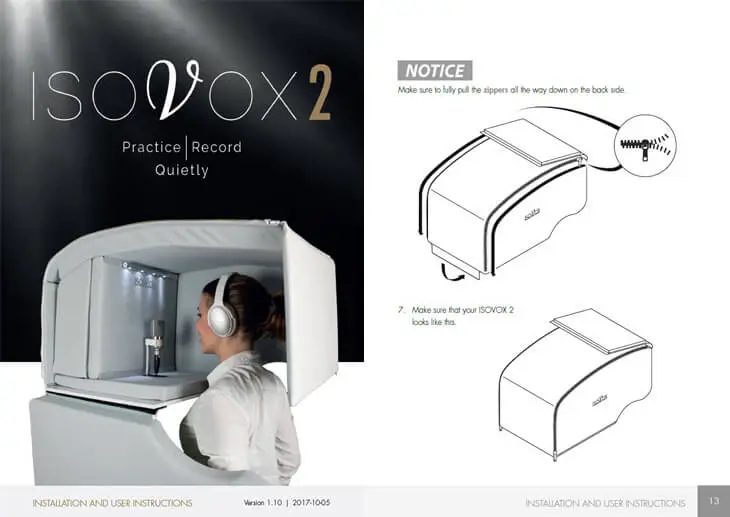
This article describes exactly the steps we followed. Although Philip used a paid template, I've created a free one that gives you the same results. There is only one difference.
The paid templates already contain the mandatory legal parts for machinery (EU, UK, US), electrical equipment (EU, UK, US) or medical devices (EU, UK, US), which means that you can skip step 6. The free template is a more generic one.

When you choose to use the free one, make sure to follow the instructions from step 6. You can download the free template here:
![]()
Before using the User Guide Template and my other tools for Philip, I wanted to ensure we're on the same page. I provided him with some general information about user instructions and a good existing user manual example.
I have listed this information below.
A user manual is a technical communication document intended to give assistance to people on how to use a product. A good user manual assists users on how to use a product safely, effectively and efficiently.
Other names, or other forms of a user manual, might be:
In addition to helping users, user manuals should also improve the user experience and meet legal demands.
A user manual consists of textual visual information (illustrations, screenshots, tables etc.) to assist the user in completing specific tasks.
The user plays the central role when drawing up a user manual. A well-drafted user manual only provides that information that is relevant for the intended user of the product.
A user manual should have step-by-step instructions and the conceptual information for users to understand those instructions.
A step-by-step user guide template is useful for presenting instructions to users in a structured and comprehensible manner. This format ensures that users can easily follow the provided information, making the manual more user-friendly.
A good user manual is concise and uses jargon-free language. A good user manual should answer HOW and WHAT questions. They should contain information about what happens if a task is not done correctly.
In some cases, a product is designed for use by various user types. Typical user types are the end-user, installer, maintenance engineer and operator. Different user types require varying language, tone of voice, and conceptual information.
Take the shortest way to a compliant manual. We have developed user manual templates for machinery, medical devices and electronics that contain all legal content.
Different kind of products need a user manual. A product can be a system, tool, device, an instrument, a piece of software or an app. Depending on the type of product, a user manual might include things as:
The main tool that I developed to help Philip draw up his user manual is a User Manual Template. The template contains all the information and more from the list above. It complies with the requirements for his product.
You can use the User Manual Template to create manuals for your software, tool, device, or instrument, including installation manuals, software manuals, operational manuals, maintenance manuals, or training manuals.
Based on the first template for Philip, we have developed templates for the following product groups:

User manuals can come in paper format or as electronic documents (PDF, online, or on-device in HTML). My user manual template is a printable MS Word document.
You can create user manuals using a variety of tools. Each tool has its own advantages and disadvantages. I will mention the most common tools below:
| Advantages | Disadvantages | |
| Word | Easy to learn User manual template can be set up easily | Less suitable for large documents No reuse of content possible |
| Indesign | High degree of design freedom | Content changes may require many extra DTP hours |
| CMS (technical authoring & publishing solutions) | Reuse of content All in one solution Omni-platform publications Contains default user manual templates | High learning curve |
While drafting a user manual with help of the User Manual Template, it can be handy to have some good examples. Through the following links you can download a user manual sample for documentation:
Ok, so now Philip has some basic knowledge about user manuals. Let’s dive into the details and actions.
To create a problem-solving manual, start by defining your user. You can do this by creating a user profile, also called a persona.
With a persona, you make some reasonable assumptions about the characteristics of your user. This is not only useful for creating your user instructions, but it is an essential element at the start of the development of any product! As an educated industrial design engineer, this is how we started all our design assignments.
When checking the ISOVOX website, I didn’t even find a clear description of their intended users. That’s why I asked Philip to define his users and answer questions like:
I have created a template that contains the questions. I asked Philip to fill out the template.
You can use the template yourself to determine who your user is. Please note that the second tab also contains Philip’s answers, so you have an example of how the sheet could be used.
Action: Use the template to describe your user(s).
I am a HUGE fan of visualizing things. So if you want to take defining your user one step further, I would suggest you visualise your user in the form of a persona. When creating a persona you are giving your user a name, age et cetera, so it becomes a real person that represents your user.
I did this for Philip. This is the result:

Action: Create a visualization of your user
If you want to know more about defining your audience and creating personas:
Start with identifying the problems that your user(s) might encounter during the lifecycle of the product and that s/he wants to solve. Typical problems might include: installing the product, using the product, using the product safely, maintaining the product and disposing of the product.
If the problem is too complex, you could break it down into chunks.
I asked Philip to identify the problems and solutions that his user might encounter during the product lifecycle. In order to do so, I created another template for Philip. In the left column of the Lifecycle tab, the stages of a product’s lifecycle are mentioned. These are derived from the international standard for user instructions, the IEC/IEEE 82079. Our user manual templates are compliant with this standard.
On the Lifecycle [ISOVOX] tab you see how Philip adjusted the lifecycle to his own product.
Action: Use this template and the instructions on the first tab to identify the problems your user might have during the lifecycle of your product and present their solutions.
If you want to know more about defining your user’s problems and creating topics:
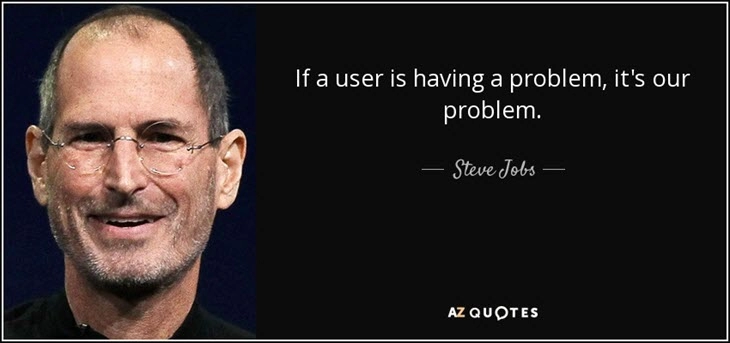
Philip has now identified the problems a user might have with his product during its lifecycle and he has now thought of the solution to solve the problem. In other words: Philip has defined the topics for his user manual. Each topic can only be about one specific subject, has an identifiable purpose, and must be able to stand alone.
A topic should give the answer to only one user’s question. A user wants to solve one problem at a time. When a user has solved the problem, he/she will go and solve the next problem.
A topic will become a section in the user manual. It can be a chapter or a (sub-)paragraph. As soon as a user is looking for an answer to his problem, he will use the table of contents to find out how to navigate to that answer.
I asked Philip to structure the topics and define their place in the user manual, by assigning a certain topic to a specific chapter or (sub-)paragraph. The result can be seen on the ToC [ISOVOX] tab.
Action: To define the structure of your user manual:
You have now created the Table of Contents (ToC). The ToC is the outline of your user manual. Later we will add some more topics/sections, like the Introduction, Safety Information etc., so don’t worry about adding that now.
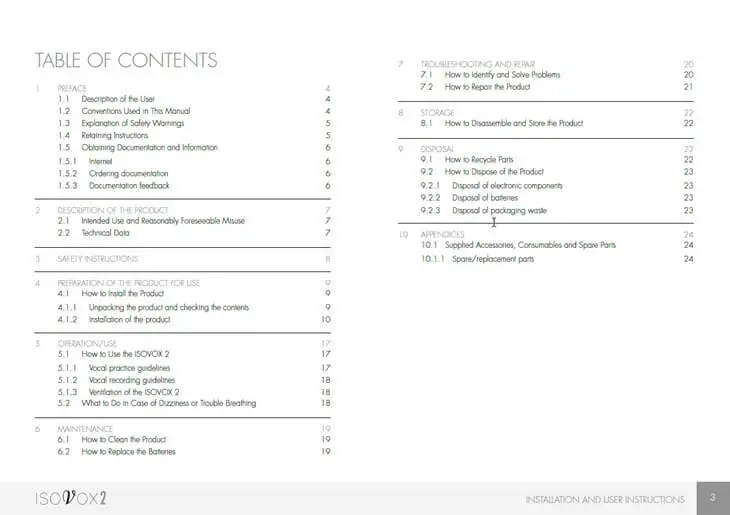
The Isovox table of contents
Each topic in the user manual gets its own heading. The headings are the (sub-)titles that precede the actual text. They appear in the ToC, so the user can navigate to the needed information.
So, Philip has just created the (sub-)titles for his topics.
Because the ToC entries play such an important role in helping your user find their way, and to help them skip what is NOT important, they need a bit more attention.
Basically, you should try and work with three levels of headings: first-, second- and third-level headings.
The first-level heading describes what the entire chapter or section is about (e.g. INSTALLATION OF THE PRODUCT). The second-level headings should use the ‘how what’ style of phrasing (e.g. How to Assemble the Product and How to Do the Electrical Installation). A third-level heading uses noun-phrases (e.g. Packaging contents and Tools to be used).
I asked Philip to redirect his headings and to take notice of the following general guidelines:
Action: Write new headings for your ToC entries.
Philips’s ToC with meaningful headings can be found on the ToC w. Meaningful Headings tab.
Dependent on the market where your product is placed in or put into service, and dependent on the product group your product belongs to, specific legislation applies to your product.
In general, the legislation requires that your product is ‘safe’ and therefore gives general safety requirements your product should meet.
These requirements also include requirements on the content of your user manual and safety instructions.
In order to sell your product in a specific market, you should make sure that your user manual complies with these requirements.
These two articles below will tell you how you can find out exactly which legislation applies to your product for the European and U.S. market and what the requirements are for your user manual. Pro tip: when there is a Declaration of Conformity available already, you can find the applicable directives in there.
Philip didn't need to conduct these steps, as the template he used already contained the legal content as required by the relevant directives.
For his product, it means that the following information is required for the user manual for his product:
EU (relevant CE marking directives: LVD, EMC, RoHS, WEEE, REACH):
Besides this legislation, there also is an international standard for user manuals, the IEC/IEEE 82079-1:2019. This standard has been harmonised in the EU. Compliance with harmonised standards provides a presumption of conformity with the corresponding legislation!
I have also created an IEC 82079 checklist that can be used to double check that your user manual complies with this standard.
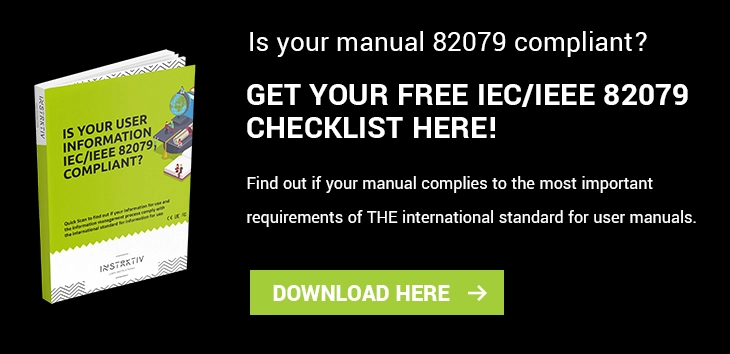
In order to create an internationally compliant user manual, you should always make sure your manual meets the EU, US and 82079 requirements.
Action: To determine the legal requirements on your user manual:
In this video I explain how you can create a manual that complies with the 82079 standard:
Now Philip can start the actual creation of his user manual.
I asked him to adjust the table of contents of the template according to his own table of contents. Without removing and mandatory elements of course.
Do you remember from step 4 that I asked to start the numbering of the sections with chapter 4? Once you download the user manual template doc yourself, you will see that a few standard chapters have been added, as well as some appendices.
Action: To adjust the user manual template:
If you want to work with the free template:
Or use one of our paid templates that contain all mandatory content, like Philip did.

The purpose of your product, or better: the intended use, is the heart of a user manual and forms the basis of ensuring the safe and healthy use of the product.
The way the intended use is described also determines your liability and affects the further contents of the user manual.
The most legislation requires you to include a description of the intended use in the user instructions.
The international standard for user instructions, the IEC 82079-1, provides the following definition for the intended use:
An exhaustive range of functions or foreseen applications defined and designed by the supplier of the product
By describing the intended use you determine the safe envelope of the product. And once you have determined the intended use, you can focus on providing only those safety and user instructions for how to use the product within the given envelope.
Additionally, to the intended use, many more standards, directives and regulations also require you to include a description of the reasonably foreseeable misuse.
For example, the reasonably foreseeable misuse of an aggressive detergent could be the use of it in a food processing environment.
Paying too little attention to describing the reasonably foreseeable misuse will affect a company's liability.
Product liability laws/regulation hold a manufacturer liable for a defective product. If the defectiveness of a product needs to be determined, all circumstances will be taken into account. That includes the reasonably foreseeable use of the product.
The description of the intended use determines which instructions are given in the rest of the manual. For example, if a cooling system is only used for cooling certain medications, then only these procedures need to be described.
When it could reasonably be foreseen that the cooling system may be used as a system to cool organs, this should be described in the instructions. By doing so, you, as the manufacturer, will limit your liability and you can focus on only describing how to use the system to cool medicines.
Action: write the intended use and the reasonably foreseeable misuse of your product.
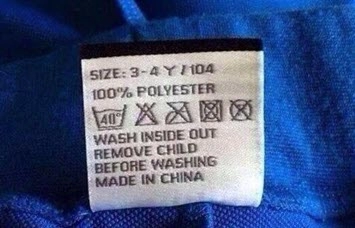
Figure 1. Reasonably foreseeable misuse?
Even though the intended use has now been clearly defined, this does not mean that using a product is completely without any risks.
To identify the hazards that come with the use of a product, you can conduct a risk analysis. A risk analysis can also be mandatory for certain product groups, such as low-voltage equipment, toys, machinery and equipment for use in explosive atmospheres.
Standards, like the ISO 12100, have been developed on how to conduct a risk analysis. The ISO 12100 also gives a method for taking mitigation measures: the Three-Step Method. According to this method, there is the following hierarchy of risk-reducing measures:
This means that the user guide should warn of any residual risks related to the use of the product. This is done with safety warnings.
A good safety warning describes the nature of a hazardous situation, the consequences of not avoiding a hazardous situation and the method(s) for avoiding it.
To indicate the degree of hazard that may be encountered by the user, the signal words “Danger”, “Warning” and “Caution” should be used.
Have a look at the following safety messages:
WARNING! Rotating parts. Risk of serious injuries. Keep hands clear. Lockout/Tagout before servicing.
Then you want to warn the user where a hazardous situation might be encountered. The ANSI Z535.6 standard describes the following locations in the user manual where this could be:
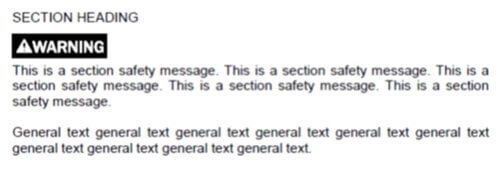
1. Do this.
2. Do that. WARNING! This is embedded safety messages. General text general text general text.
3. Do this.
In the EU, depending on the kind of product, it might be allowed to provide only the safety information in printed form and the rest of the information online.
In order to help Philip create and place a safety message, I have created another template.
Action: conduct a risk analysis and craft your safety messages using this template.
Now I asked Philip to create all other content, such as the procedures, technical specs and legal information.
I gave the following tips:
Action: create all other content for your user manual.
Again, for most product groups there are paid templates available which might make the work easier. These templates contain all legal texts, mandatory disposal information, copyright statements and comply with the IEC 82079 standard on user instructions.
When using the template for crafting the safety messages, I asked Philip to indicate whether a safety message is a supplemental directive, or should be placed as a grouped, section or embedded safety message.
Now all text has been created, the safety messages can be placed in the right place.
Action: place all safety messages in the right location in the user manual.
A user manual should give assistance to people by providing information about how to use a product. Finding the right information that solves the user’s problem should take as little time as possible.
The crafting of meaningful headings is one of the tools that aid users in finding information. However, there are several other tools to help the user finding the information he/she wants, such as:
I asked Philip to update the table of contents and add page numbering and an index.
Action: Add or update your table of contents, page numbering and index.
Philip has now created the draft version of his user manual, using the user manual template. We call this version the textual content design.
As Philip has a business partner and a developer with in-depth technical product knowledge, I asked Philip to let them review the work so far.
Both his business partner and the developer provided feedback. Philip used this feedback to optimize the user manual.
Action: Send the draft version of the user manual to anyone within your team who might be able to deliver feedback. Ask them to combine all feedback into one document before sending it back to you. This stimulates discussion of your team members and prevents disagreement at a later stage.
Once the user manual has been reviewed and optimized, the texts are more or less definite. This means that any images can now be created and added to the content.
The reason to wait until the texts are ready is that creating or editing images can be time-consuming. As images should support, replace, or augment text, you want to wait to create them until the texts are final.
Images in user manuals may include illustrations, photos, screenshots, tables, diagrams and schematics.
There are many great tools that can help you create your images, such as:
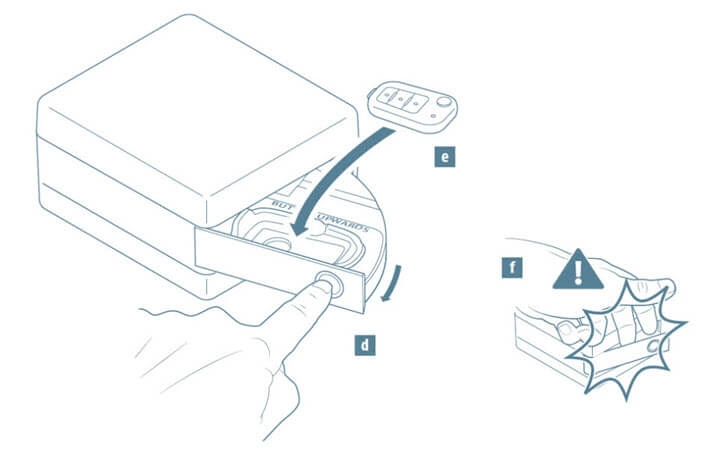
I advised Philip not to use photos as a cheap alternative for illustrations. Often, photos are not as informative because they contain too much information. Besides that, photos can make a user manual look messy.
For that reason, Philip used Google Sketchup to create his illustrations.
Action: Create the images for your user manual.
If you want to know more about creating images:
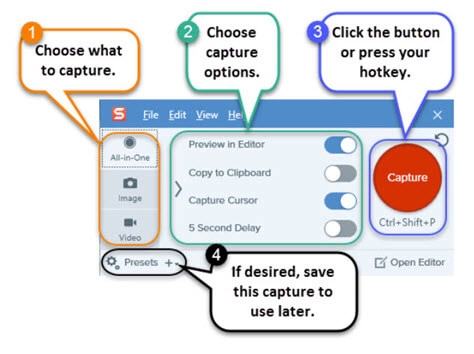
Before we start making it look nice and translate the content, we want to be sure that the content is complete.
In order to do so, I asked Philip to use a checklist.
Action: l make sure that your user manual complies with all relevant requirements from the IEC/IEEE 82079-1 by using this checklist.
A well-designed manual contributes to a better brand and user experience.
You can adjust the User Manual Template in MS Word by adding a company logo and adjust the font, colours et cetera, but that might have limitations.
When you know how to work with Adobe Indesign, or are willing to learn to work with it, this will offer you much greater design possibilities.
I created this template in Indesign and asked Philip to adjust it to match his brand identity.
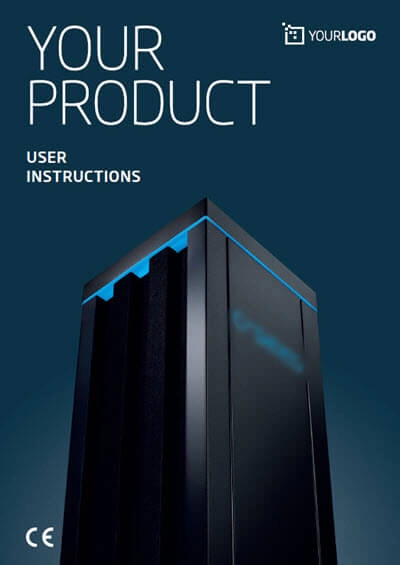
Action: Adjust the User Manual Template to fit your brand identity, or download the InDesign user manual template and adjust it.
DTP stands for Desktop Publishing and Wikipedia describes it as ‘the creation of documents using page layout skills on a personal computer primarily for print’.
Philip now has both the content of his user manual (Word file) and the user manual template (InDesign file). The content needs to be put into the InDesign template. This is called Desktop Publishing.
Action: place the content from your Word file into the Indesign template. If you decided not to use the InDesign template but stuck to the Word file, then you can skip this step.
Depending on the market in which you are going to sell your product, you might need to translate the user manual.
Some general tips:
As Philip will sell his product in both the US and EU, he decided to work with an agency.
Action: Find a translator or agency that fits your needs and have your user manual translated.
In general, a user manual should be available in a format that is easily accessible to the user. That can be printed, or used online or on-device.
As a user wants information at the moment he/she needs it and thus does not think in channels, the best approach would be to provide the instructions omni-platform.
In the European Union, for some product groups, it is still restricted to provide the user manual printed with the product.
However, as of April 2016, the instructions of many product groups may be delivered in a different format rather than in print. There is one exception, however.
Safety information shall still be delivered in paper form along with the product. Besides that, upon request from a consumer, a paper user manual should be made available to the consumer.
Philip decided to the following:
That’s all there is to it. That’s how Philip created a compliant user manual with help from the User Manuals Template and the other available tools that I provided.
The best part of all this is that you can get the same results as Philip did by following this step-by-step process on how to create a user manual.
If you found this case study inspiring, I’d really appreciate if you would share Philip’s story on
Facebook or Twitter, or leave a comment below.
Ferry Vermeulen is a technical communication expert and director at INSTRKTIV. It's Ferry’s mission to create digital user instructions for all products in the world. Listen to the INSTRKTIV podcast on Spotify or read one of his latest blog articles.
Take the shortest way to a compliant manual. We have developed user manual templates for machinery, toys, medical devices and electronics that contain all legal content.